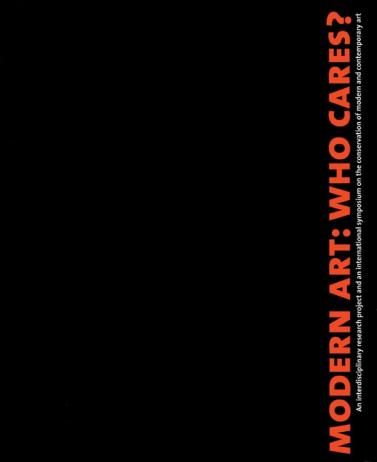
Location
AmsterdamDate and time
-An international symposium on the conservation of modern art
8-10 September 1997
Amsterdam, The Netherlands
Organiser: Foundation for the Conservation of Modern Art/Netherlands
Institute for Cultural Heritage
Objectives of this conference were to discuss the results of the research project ‘Conservation of Modern Art’ (Foundation for the Conservation of Modern Art, 1996-97), and to raise and refine an understanding of the general conservation issues regarding modern art. The three day symposium included 20 papers, 17 seminars (on topics such as artists’ materials, preserving artist’s intent, training, ethics, legal aspects, electronic media, installation art), the director’s and roundtable discussion. There was also a concurrent exhibition in the Museum Boijmans Van Beuningen of the works investigated during the research project. Proceedings of the symposium were published in the book ‘Modern Art: Who Cares?’ (1999).
Conclusions of the symposium Conservation of modern and contemporary art is only possible if information is available on the materials and techniques used by the artists and, not least, what they mean to the artists. The fact that these data are largely unavailable endangers the preservation of modern and contemporary art. Documentation and research in these areas should become a structural part of the conservation of modern art.
There are often no published precedents for conserving modern and contemporary art. Museums of modern art therefore will have to make a clear choice for their international, national or regional function as institutions whose task it is to preserve twentieth-century art. Museums will have to invest heavily in the collection and availability, research and exchange of this information.
Interviews with artists are a major instrument in the collection of information. Research into the documentation and conservation of 'immaterial' artistic expressions merits special attention. Art-historical and art-theoretical research is necessary in order to develop a methodical approach to the collection of these data.
More and more efficient collaboration is of vital importance, both within the museums and among the institutions and the various disciplines, conservators, curators, conservation scientists, artists and managers. Free lance conservators working independently should also be part of this network. Collaboration and exchange should be developed in particular in the following areas.
Opening up findings of research into methods and techniques of conservation, scientific and material research and information on former conservation treatment. Information on materials and techniques used by artists, and their meanings. Accessibility of these data on the Internet, by means of an international information network. Conservation is not just the task of conservators, but the responsibility of the museum organisation as a whole, including the management level. There is a need for the development of clear logistic and management systems aimed at the use and conservation of modern and contemporary art, centred on the diversity of materials and their meanings. When works of art are bought, the consequences regarding their conservation are to be assessed and integrated into the management right from the start.
Methods of risk management are to be developed especially for these fragile and diversified collections, and are to be integrated in the conservation policy.
© Foundation for the Conservation of Modern Art/Netherlands Institute for Cultural Heritage
Click on the tag below MODERN ART: WHO CARES? to access PDFs of articles from the Modern Art: Who Cares? publication.